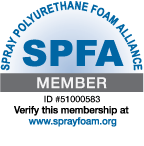Resources
Closed Cell Spray Foam
With the overwhelming amount of flood damage to buildings from the 2017 hurricane season in Texas, Florida and Puerto Rico, SPFA has issued TechTip for contractors. This TechTip, entitled “Flood Resistant Construction Using Closed-Cell SPF”, provides a list of resources for remediation of flood damaged buildings. It also contains information on rebuilding techniques to create flood-resistant walls designed to dry more quickly, with special emphasis on flood-resistant insulations such as closed-cell SPF.
"Many building codes in the U.S. require the application of a Polyethylene vapor retarder…designed to reduce the condensation problems that frequently occur in fiberglass batt and other types of insulation." Prepared by Corbond
"Closed Cell Spray Polyurethane Foam gives full coverage and expands in place, which allows it to air seal construction gaps, plumbing and electrical penetrations, as well as joints of dissimilar materials such as roof deck/wall junctions." Prepared by Steve Loftis
"Flooding accounts for a large percentage of the damage caused by a coastal storm. Building materials exposed to flooding must be resilient enough to sustain a certain amount of water exposure in order to avoid the need for complete replacement after the flood. Example: Closed-cell foam." Prepared by FEMA
"Rigid polyurethane and polyisocyanurate (polyiso) foams are some of the most efficient thermal insulating products for buildings and for improving the efficiency of the building envelope." Prepared by Alliance for the Polyurethanes Industry
"…spray foam insulation is a superior insulation product that overcomes several disadvantages of other insulation products. Spray foam insulation can provide a more uniform, consistent thermal barrier as well as provide air flow retarder functions." Prepared by RLC Engineering, LLC.




